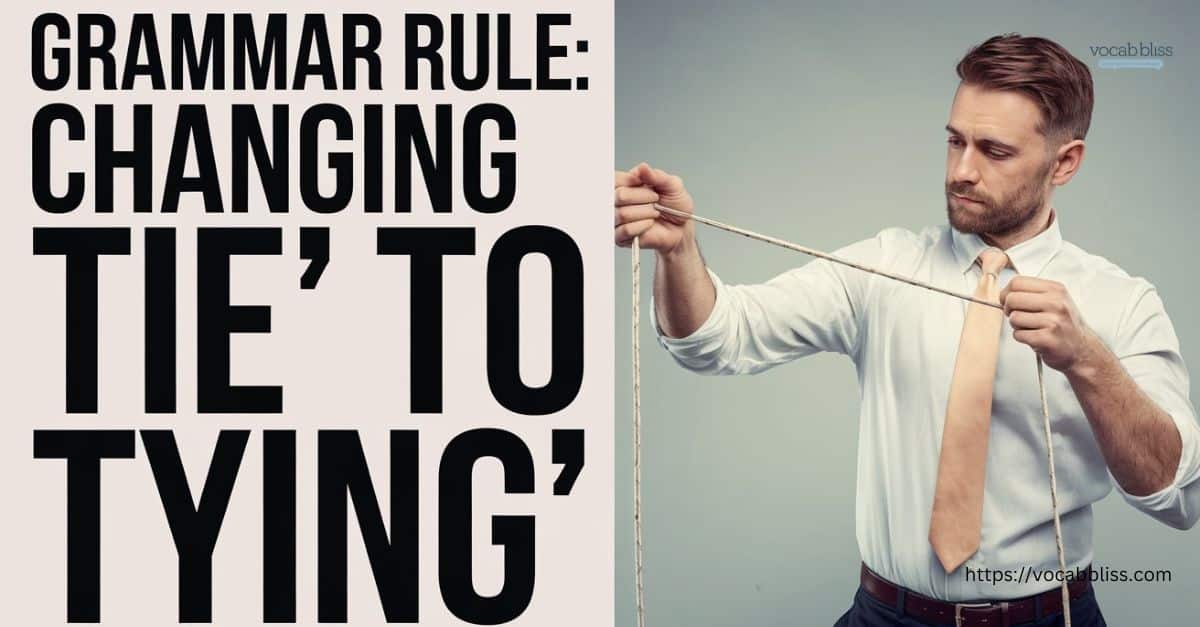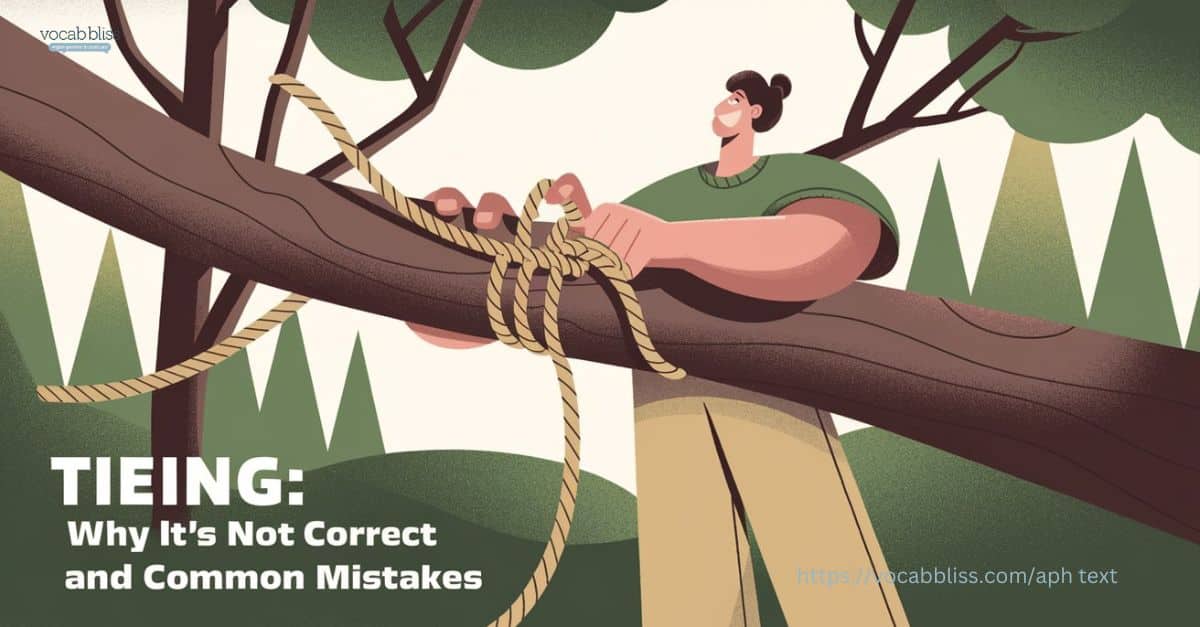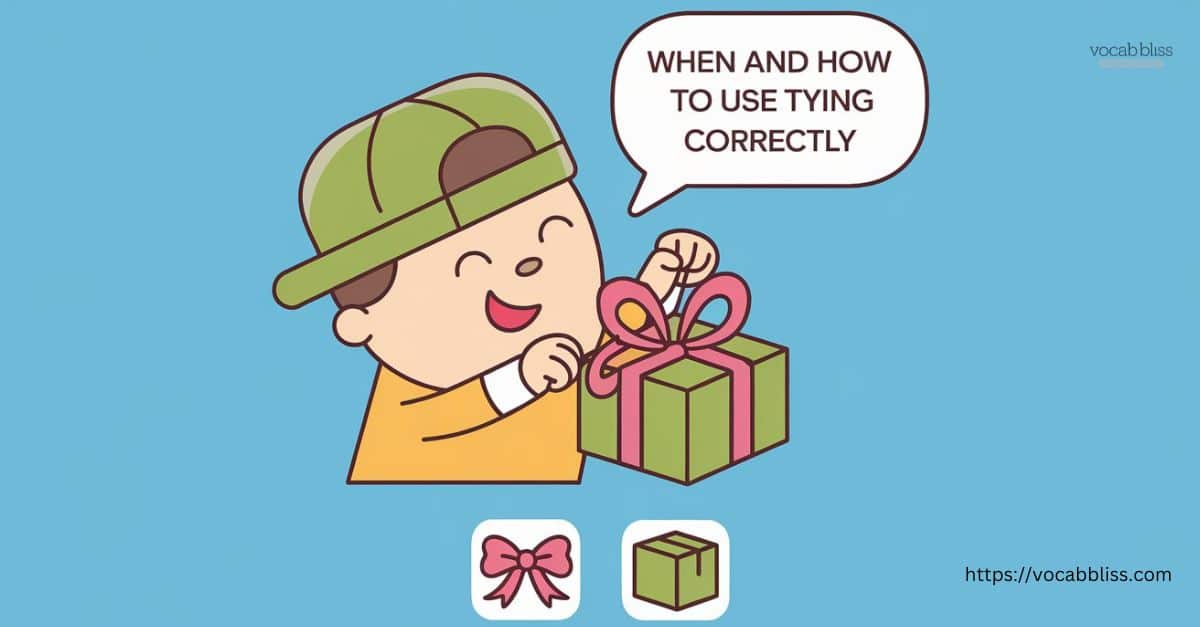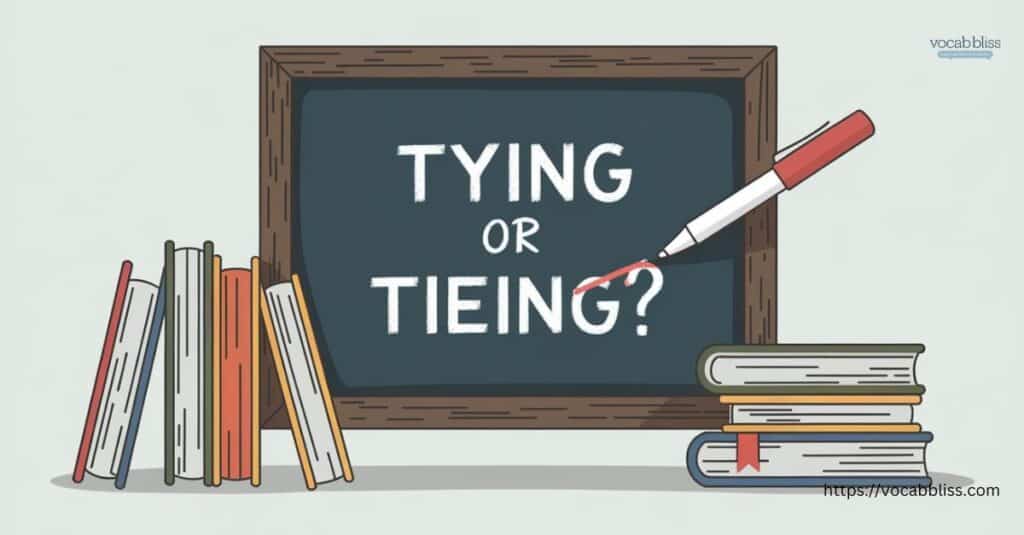Confused about whether “tying” or “tieing” is the right word to use? You’re not alone. It’s a common dilemma that often arises when spelling certain verbs with an “-ing” ending. In this article, we’ll explore the differences between “tying” and “tieing,” look at the grammar rules behind each form, and provide practical examples to help you master the correct usage..
Whether you’re tying shoelaces, securing a boat, or finalizing event details, you need to know the right word. This guide thoroughly explores every aspect of this linguistic puzzle, ensuring you achieve a clear understanding of the correct form and its proper usage.
Understanding the Difference Between Tying and Tieing
At first glance, both “tying” and “tieing” seem like they could be correct. However, only one is considered standard English. The confusion usually arises from how verbs transform into their “-ing” forms. Let’s explore why this happens and clarify the grammatical rules behind it.
- Tying: The standard and grammatically correct form of the verb “tie” in its present participle form.
- Tieing: An incorrect or non-standard form, occasionally found in older texts but not considered proper usage in modern English.
To fully understand why “tying” is correct while “tieing” is not, we need to look at how verbs ending in “e” typically change when adding an “-ing” suffix.
Tying: Definition, Etymology, and Correct Usage
Definition of “Tying”
The word “tying” serves as the present participle form of the verb “tie.” It indicates an ongoing action, such as in “tying the knot” or “tying up loose ends.” Essentially, “tying” means to fasten, secure, or create a knot in something, typically using string, rope, or fabric.
Etymology of “Tying”
The verb “tie” originates from the Old English “tīgan,” which means to fasten or bind. Over the centuries, the usage has evolved, but the basic meaning stays the same. The shift to “tying” follows standard English grammar rules for verbs ending in “e.”
Grammar Rule Behind Changing “Tie” to “Tying”
To form the present participle of verbs that end in “e,” you generally drop the “e” and add “-ing.” Here’s how this rule applies:
- Tie → Tying
- Drive → Driving
- Give → Giving
The rule helps to maintain consistency and prevent awkward spellings that could disrupt the flow of reading.

Everyday Usage of “Tying”
- Tying up loose ends: Used metaphorically to mean finishing incomplete tasks.
- Tying in: Integrating an idea or connecting two subjects.
- Tying the knot: A common expression used to refer to getting married.
When used in these phrases, “tying” functions as a part of everyday language, appearing in both formal texts and informal contexts.
Tieing: Why It’s Not Correct and Common Mistakes
Why “Tieing” is Incorrect
The form “tieing” is not considered standard English. It doesn’t follow the conventional rule of dropping the “e” before adding “-ing.” Although it occasionally appears in less formal writing or older texts, it is not recognized in formal dictionaries or grammar guides.

Common Mistakes Involving “Tieing”
- Misspelling in Essays or Articles: Writers may mistakenly use “tieing” when they are unaware of the grammar rule.
- Usage in Informal Writing: Some casual blogs or online forums may feature “tieing” due to lack of editing.
- Confusion from Similar Words: Words like “dying” (from “die”) can cause some to think “tie” should become “tieing,” even though it doesn’t follow the same rule.
Older Texts and Rare Usage Cases
“While ‘tieing’ might appear in older writings or informal settings, it’s not standard today. However, that doesn’t make it grammatically correct by modern standards. Always choose ‘tying’ to ensure accuracy.”
Visual Comparison: Tying vs. Tieing
| Aspect | Tying | Tieing |
|---|---|---|
| Correctness | Correct | Incorrect |
| Grammar Rule | Follows standard rules | Does not follow grammar rules |
| Common Usage | Yes | Rare, non-standard |
| Formal Texts | Suitable | Not suitable |
| Informal Contexts | Appropriate | Sometimes seen, but incorrect |
To clarify why “tying” is the correct phrase to use, the table above offers a side-by-side comparison of “tying” versus “tieing.”
Grammar Rules for Forming -ing Words
Review some general rules for converting verbs that end in “e” to their “-ing” forms to solidify your understanding of why “tying” is correct.
Rule 1: Drop the “e” Before Adding “-ing”
For most verbs ending in “e,” simply remove the “e” before adding “-ing”:
- Make → Making
- Take → Taking
- Bite → Biting
Rule 2: Irregular Forms and Exceptions
Some verbs don’t follow the typical pattern, such as:
- Be → Being
- See → Seeing
These are exceptions rather than the norm.
Additional Examples of Similar Verbs
- Lie → Lying
- Die → Dying
- Write → Writing
By following these rules, you can avoid common spelling differences and maintain proper usage in your writing.
Examples of Everyday Usage: When and How to Use Tying Correctly
Correct Usage Examples
- Tying up loose ends before a meeting ensures all tasks are complete.
- We spent the afternoon tying ropes together for our climbing expedition.
- Tying the knot was a memorable experience during our wedding ceremony.
Incorrect Usage Examples
- They were tieing the boat to the dock. (Should be “tying”)
- The scouts practiced tieing knots. (Should be “tying”)
Read More Piece or Peice? Figuring Out The Differences

Real-World Cases Where “Tying” is Used
In practical settings, such as sailing hobbies or climbing expeditions, people often use “tying” to describe the process of making complex knots. This illustrates how everyday language incorporates this form to convey specific actions..
Commonly Confused Words with Similar Spelling Rules
Several other word pairs follow the same spelling pattern as “tying.” Here are a few examples to clarify this rule:
| Base Verb | Present Participle (-ing Form) |
|---|---|
| Tie | Tying |
| Lie | Lying |
| Die | Dying |
| Write | Writing |
| Drive | Driving |
These words demonstrate consistency in the application of the rule, making it easier to recognize the correct form.
Frequently Asked Questions (FAQs) About Tying vs. Tieing
Why Isn’t It Spelled “Tieing”?
The spelling “tieing,” however, doesn’t adhere to standard English grammar rules for forming present participles. Instead, in most cases, you drop the “e” to simplify pronunciation and maintain consistent spelling conventions.
Are There Any Exceptions to This Rule?
While there are a few irregular forms in English, the word “tying” does not qualify as an exception. The rule for dropping the “e” and adding “-ing” applies broadly, with a few notable outliers like “seeing” and “being.”
Can “Tieing” Be Used in Informal Contexts?
Although you might encounter “tieing” in casual writing, it’s still not considered correct. For professional or academic writing, always use “tying” to ensure proper usage.
Read More Tomorrow or Tommorrow: Which One Is Correct?
Conclusion
Understanding the difference between “tying” and “tieing” helps improve both written and spoken English. While “tying” follows standard grammar rules and is widely accepted in both formal texts and everyday language, “tieing” remains a non-standard form that should be avoided. By remembering to drop the “e” before adding “-ing,” you can ensure you’re using the correct phrase every time.
If you want to explore more about common expression variations, grammar rules, or other spelling differences, feel free to check out our related articles on English grammar and vocabulary usage. Now go ahead and start tying up all those loose ends with confidence!
Quick Reference Table for Tying vs. Tieing
| Term | Correct Form? | Usage |
|---|---|---|
| Tying | Yes | Used for present participle of “tie.” |
| Tieing | No | Incorrect form; not used in formal texts. |
| Correct Phrase | “Tying” | Applicable for all correct usage examples. |
| Everyday Language | “Tying” | Appears in phrases like “tying the knot.” |
Mastering spelling and grammar rules enhances clarity and enriches your writing skills. Therefore, always strive for accuracy to ensure your message is communicated effectively. Additionally, focus on using the correct form so that your words connect seamlessly with the message you want to convey.

Jorge Phillips is an experienced blogger who writes for Vocab Bliss, sharing his passion for the English language. With a knack for simplifying complex grammar rules and a focus on commonly confused words, Jorge helps readers navigate the nuances of English with ease. His insights aim to make learning engaging and practical.







